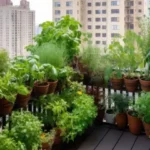Do you love gardening but live in an apartment with limited space, like a balcony or patio? Or are you facing the challenge of poor soil or concrete-covered grounds on a larger property? You may want to expand your growing space and discover alternative gardening methods, like container gardening for beginners. Fortunately, regardless of your situation, you can grow food successfully using containers, and in this article, I’m going to guide you through the process.
Choose containers wisely, ensuring each is appropriate for the plant, offers excellent drainage, and contains the correct growing medium. Opt for a suitable store-bought potting mix or create your own DIY blend while avoiding native soil to fill your pots. You’ll also want to select plants based on your growing needs and container size.
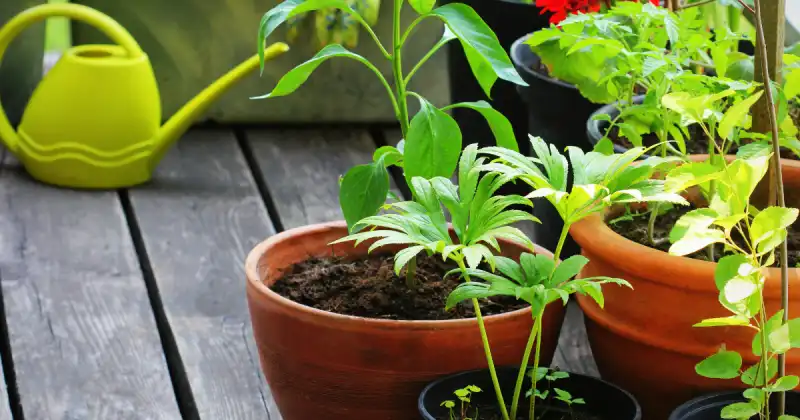
Container gardening provides the perfect solution, helping individuals to cultivate flourishing gardens regardless of their living situations. In this article, we will delve into the art of container gardening, exploring the critical elements from selecting the perfect containers and soil mixes to choosing the ideal plants for a bountiful harvest. Get ready for an exciting journey where you’ll explore countless possibilities to craft your own lush and tranquil green haven.
Humble Highlights
- Discover the 4 innovative benefits of container gardening so you can start growing delicious and nutritious potted vegetables no matter where you live!
- Stop guessing and save time by precisely knowing what sized pots you need for your veggies so you can cultivate healthy plants with full harvests.
- Discover this step-by-step guide to growing healthy container vegetables – even if you’re a complete novice – so you can establish a proven routine and grow confidently.
Container Garden Benefits
Vegetable gardening is no longer limited to larger areas. Thanks to the popularity of container gardening, this alternative approach brings numerous advantages, making it an attractive option for beginners and seasoned growers alike. Some of the best benefits of growing vegetables in containers involve the following:
- Flexibility and Mobility
- Space Saver
- Accessibility
- Increased Versatility And Control

Let’s explore these highlighted benefits in more detail.
Flexibility And Absolute Mobility
Container gardening helps you rearrange and move your garden as needed. You can quickly transfer containers around your space to take advantage of sunlight, shade, shelter, or unpredictable weather conditions. A moveable garden is helpful for growers with limited outdoor space to maximize the natural elements or who are frequently moving or changing residences. 1
Garden Space Saver
Container gardening is an excellent solution for people who live in limited spaces, such as apartments, balconies, or small and confined yards. Using containers, you can grow plants vertically or arrange them in tight spaces, making the most of every available square inch of your area.
Check Lowest Prices On Container Gardening Books Now
Accessibility
Container gardens offer accessibility advantages that other traditional garden setups don’t and are particularly beneficial for individuals with physical limitations or disabilities. Raised containers can be positioned at a more comfortable height, reducing the need for bending or kneeling while gardening. This accessibility allows more people than ever to enjoy the benefits of gardening and engage in this therapeutic hobby. 2
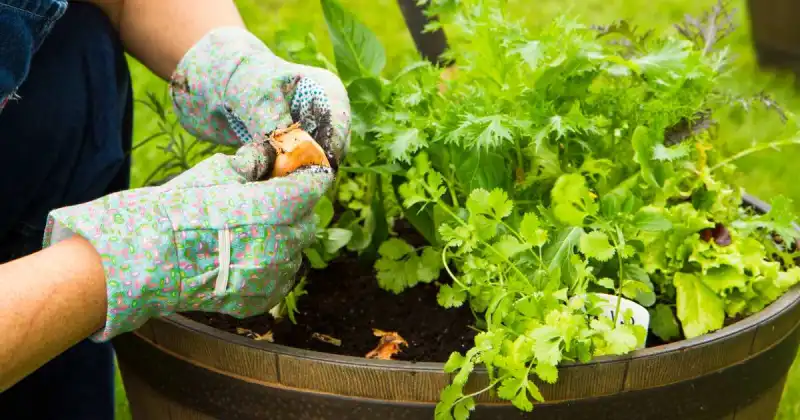
Versatility And More Control
You can cultivate various plants with containers, from flowers and herbs to vegetables and small fruit trees. Gaining more control over your operation means you are not confined to developing plants that fit within specific areas and can explore a broader range of growing options.
Choosing The Right Containers: For Outdoor And Indoor Growing
Container gardening success starts with selecting the appropriate pots for your plants. Knowing which plants enjoy extra space and which enjoy a comfier setting is essential. If you choose a plant too large for the container, you risk stunted growth and lower yields. Conversely, sowing a smaller plant in a larger pot may invite excessive weed growth, soil erosion, and wasted nutrients.
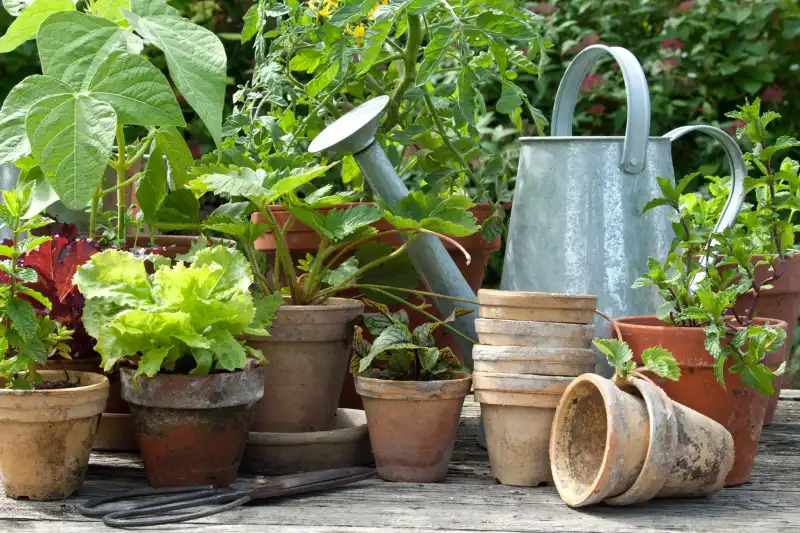
Container Size That Matches The Plant
Logic dictates that your green friend won’t be happy if you try to grow a tomato plant in a coffee can. Indeed, cultivating a larger plant in a smaller space won’t allow the plant to benefit from effectively spreading its roots, subsequently creating an avoidable unhealthy and unsustainable growing environment. 3
While it might be tempting to use unusual containers, it is essential to remember that plants need enough space for their roots to grow and absorb the vital nutrients from the soil to prosper. Whether planting young starts or sowing seeds, giving your plants the right amount of space is crucial for their health and growth.
Consider the following container sizes below:
- Extra small containers, which can contain 2 gallons or .3 cubic feet of soil, are suitable for small herbs or individual flowers such as thyme and petunias, respectively.
- Small to medium-sized containers (3 to 5 gallons or .46 to .69 cubic feet) of soil are ideal for most vegetables, compact shrubs, or medium-sized flowers, like squash or beets.
Check Lowest Prices On Containers And Grow Bags Now
- Large containers (10 gallons or 1.5 cubic feet) of soil can accommodate larger plants like fruit trees or tall ornamental grasses.
- Extra-large containers (20 gallons or 2.73 cubic feet) of soil are suitable for creating dramatic focal points with large plants like fig trees, for example.
Drainage Holes
Make sure whatever size container you select has multiple holes or is a porous mesh cloth-like material, like a smart-pot, to aid drainage. A container that allows excess water to escape prevents standing water, waterlogged soil, and root rot. Proper drainage also ensures plant’s roots receive sufficient oxygen, promoting healthy and consistent growth.
Check Lowest Prices On Large Plastic Containers Now
Color And Material
The color and material of your pots are essential and are an often overlooked aspect of container gardening. Both elements can have unique practical and aesthetic implications for plant health as well as the overall visual appeal of your garden. 4
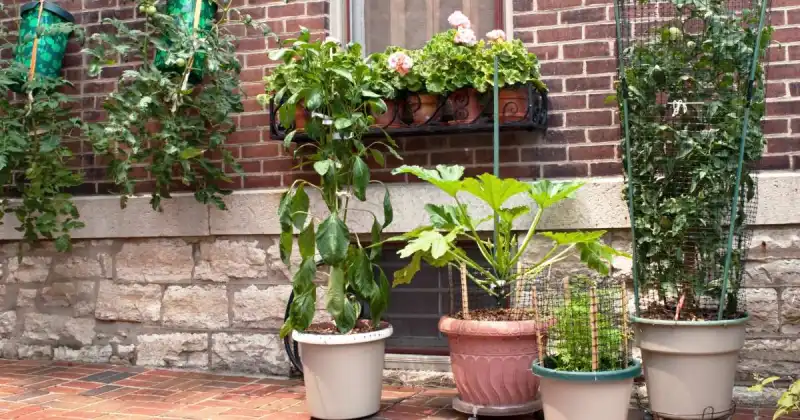
Containers with dark colors absorb more heat from sunlight, benefiting plants that prefer warmer soil conditions or cooler climates. On the other hand, light-colored selections reflect heat, making them suitable for plants that thrive in cooler soil or hot environments where excessive heat absorption can be detrimental to their overall growth.
Check Lowest Prices On Terracotta Pots Now
Regarding container materials, growers have options like plastic, clay, or ceramic. Plastic pots are lightweight, affordable, and retain moisture effectively. They are also durable and come in various colors and styles. However, choosing food-grade plastics for growing edible plants is always best.
Clay or terracotta selections are porous and allow for better airflow to the plant’s roots, promoting healthier growth. These pots also provide a natural and rugged look to any garden yet may require more frequent watering as they tend to dry out faster.
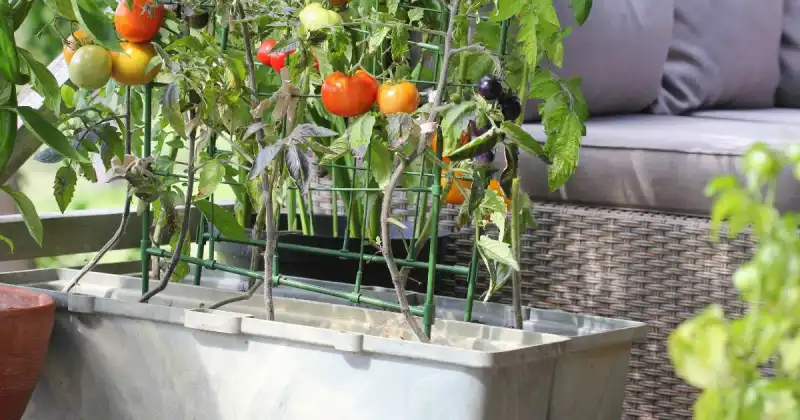
Ceramic pots are aesthetically pleasing and come in unique and colorful designs. They also offer sound insulation for the roots but can be heavier to move and are typically more expensive.
Plant The Seeds: Choosing Your Potting Soil
While you can successfully grow your garden vegetables, herbs, and fruits in containers, selecting the correct soil is imperative. Unlike traditional gardening, where native soil is typically used, container gardening requires a different approach. Using native soil in containers tends to be too dense for the roots to spread appropriately within the confines of a container. As a result, your plant struggles, and compaction may occur.
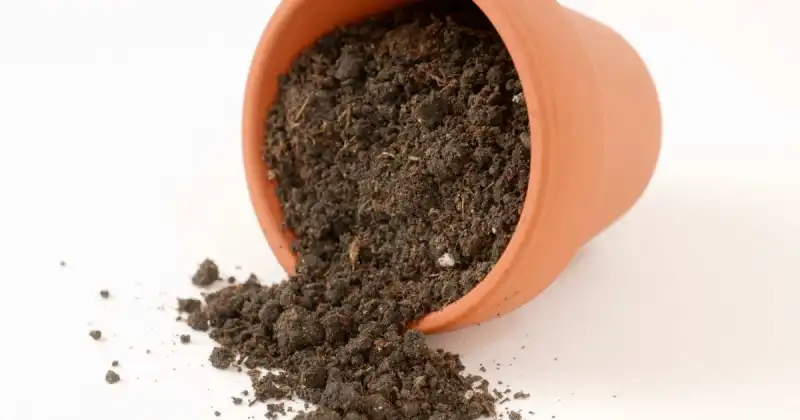
Potting Soil Mix
To start a container garden, you must have a good potting mix. Commercial potting mixes are specifically formulated for container gardening, offering a balanced blend of organic matter, perlite, vermiculite, and other components which supports plants throughout their lifecycle. 5
Commercial potting mixes are also designed to be lightweight and have good drainage properties, which ensures flourishing root systems receive enough air and nutrients while preventing waterlogged conditions. Although not guaranteed, these mixes are often free from weed seeds, pests, and diseases, reducing the risk of unwanted challenges in your garden. Some popular soil brands include Miracle-Gro, FoxFarm, Happy Frog, and Espoma.
Check Lowest Prices On Potting Soil Now
DIY Soil Mix
Creating a custom-made soil mix for your container plants offers several benefits, including allowing you to tailor the blend to meet the specific needs of each plant.
For example, if you are growing succulents that thrive in well-draining soil, you can adjust your mix by incorporating a higher proportion of perlite or sand to enhance drainage. On the other hand, if you’re developing moisture-loving plants like ferns, you can increase the amount of organic matter in the mix to improve water retention.
Check Lowest Prices On Perlite Now
Check out the video below that demonstrates how you can grow plenty of food in containers. Remember, just because space may be limited doesn’t mean that your gardening should be. This video discusses lots of excellent detail regarding this unique and easy practice, plus shares some great money-saving tips that any grower will appreciate!
Choosing The Right Plants
Although your method may be different than traditional techniques, you can grow a wide range of plants in your container garden, including:
- Herbs
- Vegetables And Fruits
- Flowers
- Trees And Shrubs
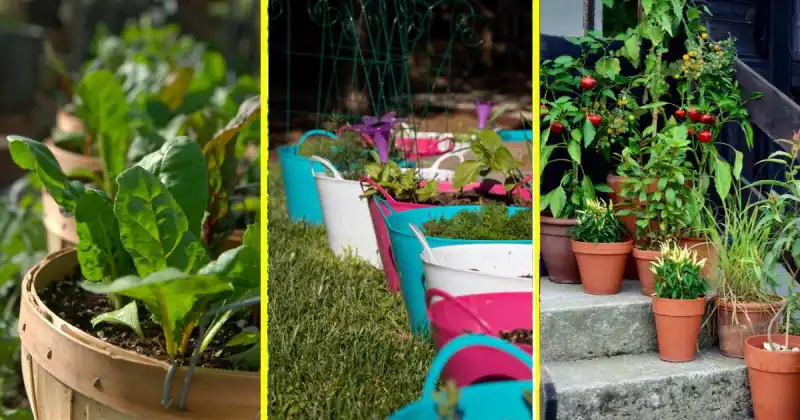
Herbs
Herbs are well-suited for container gardening due to their compact size and adaptability. Recommended container herbs include basil, rosemary, thyme, mint, lettuce, parsley, and chives.
Check Lowest Prices On Herb Seed Mixes Now
Most herbs are easy to grow, prefer well-draining but moist soil, adequate sunlight (at least 4-6 hours per day), and enjoy regular watering.
Vegetables And Fruits
Many vegetables and fruits prosper in containers, making developing fresh produce in limited spaces possible, fun, and productive. Beginner-friendly options include tomatoes, peppers, lettuce, spinach, radishes, and strawberries. You can even choose compact or dwarf varieties specifically bred for container gardening.
Check Lowest Prices On Strawberry Seeds Now
Growing vegetables and fruits require at least 6-8 hours of sunlight daily, consistent watering, and appropriate spacing, ensuring you don’t bunch your pots and create unnecessary competition for light. 6
To check moisture levels in your pots, poke your index finger into the soil up to your second knuckle. If the soil is dry, it’s time to water. Consider investing in an affordable soil moisture meter for more precise measurements.

Check Lowest Prices On Soil Moisture Meters Now
Flowers
Adding flowers to your garden completes any garden setting. Flowers are easy to grow and add beauty and a splash of color to container gardens, attracting pollinators and enhancing visual appeal. Recommended flowers include petunias, marigolds, pansies, zinnias, geraniums, and impatiens.
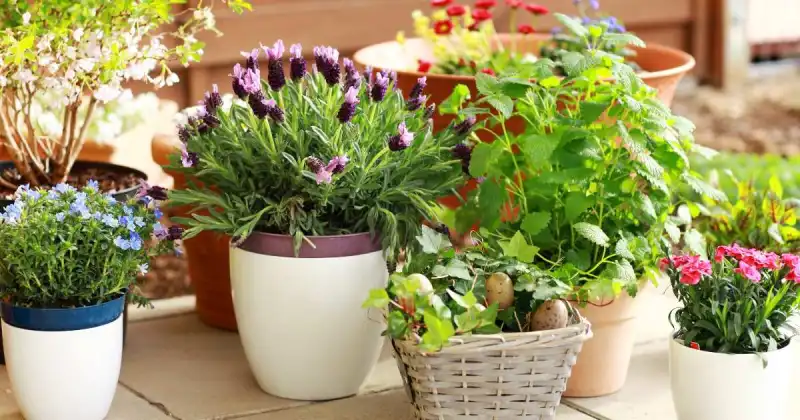
Select flowers that suit your climate, enjoy your garden’s sun and shade tolerances, and your desired color scheme. Similar to vegetables, consider how tall your flowers may get along with their spreading or creeping habits when determining the appropriate container size.
Check Lowest Prices On Marigold Seeds Now
Trees And Shrubs
Some trees and shrubs can be grown in containers, allowing for a portable garden while adding vertical interest to small spaces. Some options include dwarf citrus trees, miniature roses, boxwood shrubs, and Japanese maple trees.
However, as previously mentioned, you must ensure that your container is large enough to accommodate the maturing root system and apply the appropriate potting mix and fertilization for long-term sustainable growth.
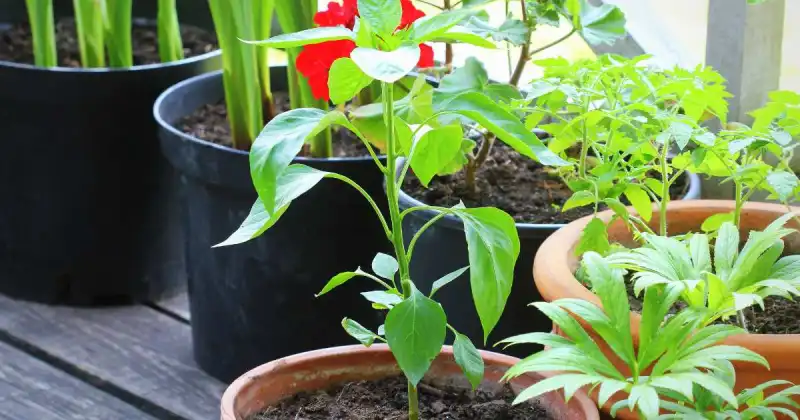
Grow Your Own Food: Beginner Planting Steps
Below is an easy step-by-step guide on planting in containers:
- Select your container. Choose a container with adequate size, drainage holes, and suitable material.
- Choose your growing media. Fill with Potting Mix or your homemade DIY mixture.
- Hydrate your soil. Soak the dirt with water before planting anything. This simple action provides a moist and cool environment and offers an excellent start for your plants or seeds.
- Prep your plants. If sowing starts, remove the plants from their nursery pots and gently rub the outside dirt with your hand loosening the roots. 7
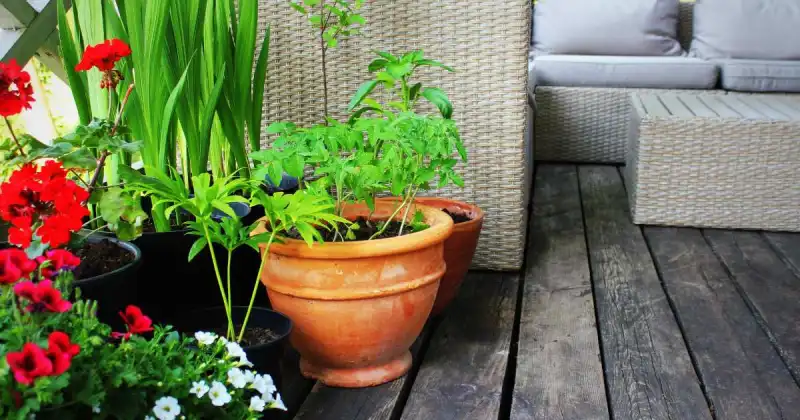
- Prep your container. Make a hole in the potting mix large enough to accommodate the plant’s root ball.
- Insert your plant. Place the plant in the hole, ensuring it is at the appropriate depth for that particular variety.
- Cover the plant’s root ball. Gently fill the gaps and firm the soil around the roots to secure the plant effectively.
- Hydrate. After planting, give the container a thorough watering. Ensure the water reaches the bottom of the container and drains out through the drainage holes.
- Position your container. Place your pot in a suitable location based on the plant’s sunlight requirements.
How To Water Your Plants The Right Way
To maintain a successful container garden, establish a watering schedule. If your pots don’t have them, create holes in the bottom of your plastic or clay containers to ensure proper water flow. By having adequate drainage, you’ll be able to see draining water which can help you avoid over or under-watering.
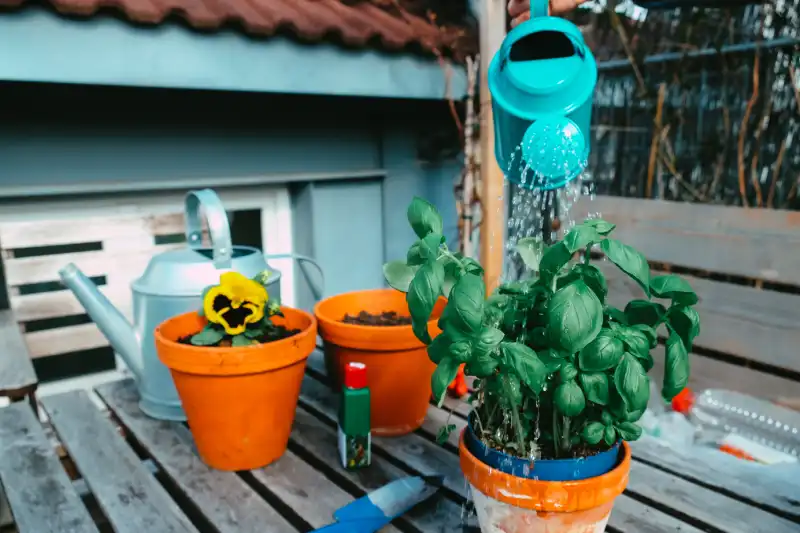
Check Lowest Prices On Garden Hoses Now
First, thoroughly watering your containers ensures no area above or below the soil line becomes dry. As previously mentioned, pots tend to dry out quickly, leaving plants vulnerable, primarily if you reside in a warm or arid climate.
Second, watering the entire surface may lessen the chances of advantageous pests taking hold. Spider mites, for example, enjoy and thrive within dry conditions. So, keeping your area moist can discourage some pests from moving in.
Apply Fertilizers
Container plants often require regular fertilization to replenish nutrients within the confined growing environment. Use a balanced, slow-release fertilizer or organic options formulated explicitly for container gardening. Applying homemade compost is an excellent way to help your soil retain moisture and provide nutrients to your budding plants.
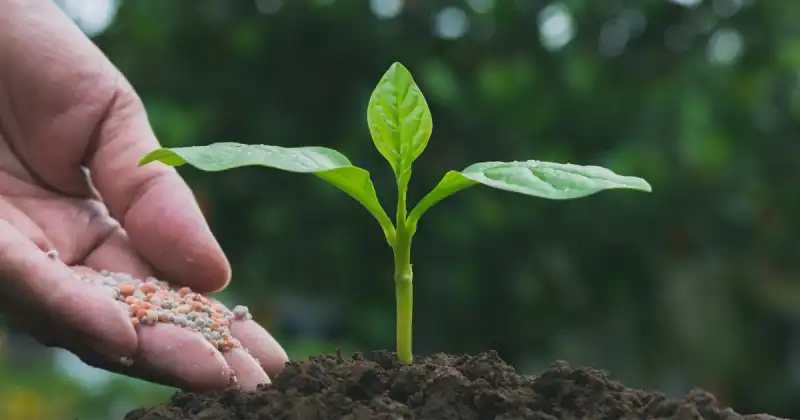
Check Lowest Prices On 10-10-10 Fertilizers Now
Remember, following your chosen fertilizer’s recommended dosage instructions and frequency is best. Consider supplementing with additional nutrients, like compost, if your foliage exhibits signs of nutrient deficiencies. 9
Pest And Disease Management
In growing vegetables in pots and containers, it is crucial to watch out for bugs and diseases. Try using natural methods to control pests, like picking them off by hand, using insecticidal soaps, applying essential oils, or encouraging beneficial predator insects like ladybugs and green lacewings into your garden. These methods keep your plants healthy and safe without harmful chemicals.
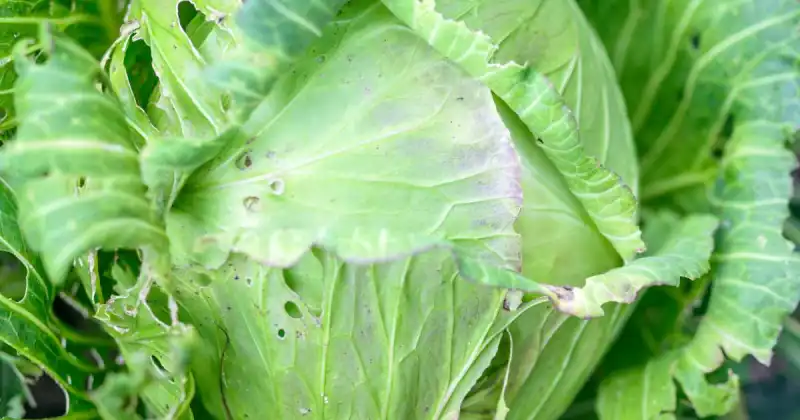
Check Lowest Prices On Neem Oil Now
As any humble gardener would, you’ll want to inspect plants regularly for any signs of diseases, such as leaf spots or fungal infections, and treat them accordingly. Remove infected plant parts and consider using fungicides if necessary, following the product instructions carefully and wearing the appropriate safety gear. 10
Check Lowest Prices On Safety Glasses Now
Consider The Season
Plants can grow in either outdoor or indoor areas. But when growing outdoors, consider their regular growing season. For example, provide adequate shade, deploy row covers, or move heat-sensitive plants to a cooler or shadier location during hot summers. In colder months, protect sensitive foliage from frosts and freezes and move them indoors when necessary.
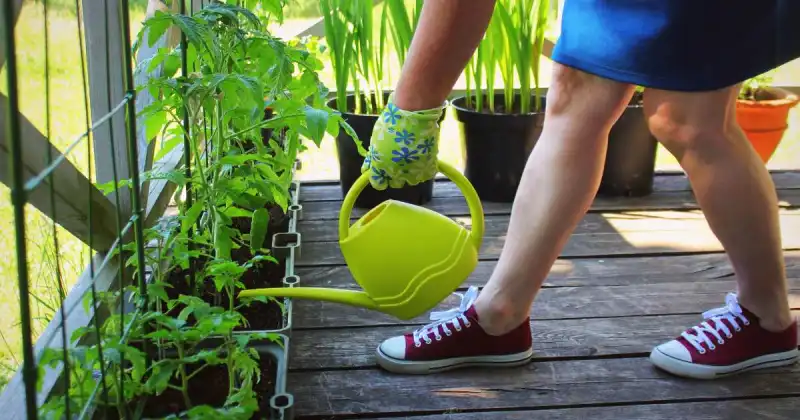
Check Lowest Prices On Row Covers Now
Container gardening also allows those with handicaps or disabilities to further their passion for gardening. However, these individuals should be mindful of how heavy their pots may become once dirt-filled, and moving heavy pots can become a challenge for those physically challenged or the elderly.
Therefore, plan and determine what plants you’ll be growing before each growing season to understand what your garden will expect from you. Call a friend, family member, or trusted friend to come by and help you move heavier pots if needed.
Final Tips
Here is a simple, step-by-step plan to summarize successful container gardening operations.
- Start with the right fruit and vegetable containers.
- Use a quality potting mix, or create your own DIY blend.
- Select plants wisely and ensure they are placed in the appropriate containers.
- Establish a watering routine that helps provide a moist growing environment.
- Apply a balanced fertilizer as needed.
- Maintain a pruning and trimming regiment and be mindful of any pests or diseases that may arise.
- Enjoy the journey!

Check Lowest Prices On Garden Pruners Now
Conclusion
Container gardening is a versatile and accessible option for beginners and seasoned growers. It offers the fantastic benefits of flexibility, space-saving solutions, and the ability to customize your garden, all while being mobile.
Growers can create a thriving container garden by choosing the proper pots that afford excellent drainage, selecting potting soil with a balanced blend of organic matter, perlite, and vermiculite, and maintaining adequate care of their budding crops.
Additionally, consider additional crucial factors, including watering, fertilizing, pruning, pest management, and seasonal adjustments to offer your potted plants the best environment possible throughout their lifecycle. And with a bit of patience and a willingness to learn, you, too, can enjoy the benefits and beauty of container gardening.
Do you currently maintain a thriving container garden? We’d love to know your story and the steps to keep it running. Let us know your unique strategy by dropping us a line in the comments below.
SOURCES
- ResearchGate – Container Gardens: Possibilities And Challenges For Environmental And Social Benefits In Cities
- University Of Illinois Urbana-Champaign, College Of Agricultural, Consumer & Environmental Sciences – Helpful Tips For Creating A Successful Container Garden
- University Of Maryland, Extension – Types Of Containers For Growing Vegetables
- Oklahoma State University, Extension – Container Gardening
- University Of Massachusetts, Amherst – Bagged Potting Mixes And Garden Soils For Home Gardeners
- The National Gardening Association, Learning Library – Getting Started With Container Gardening
- American Horticultural Society – Creating Container Gardens
- The National Gardening Association, Learning Library – Maintaining Container Gardens
- Almanac – Fertilizing Containers: Tips For Feeding Plants In Pots
- The University Of Maine, Cooperative Extension – Bulletin #2765, Container Gardening Series: Common Problems In Container Gardens
- Piedmont Master Gardeners – Container Gardening II: What To Grow & How

